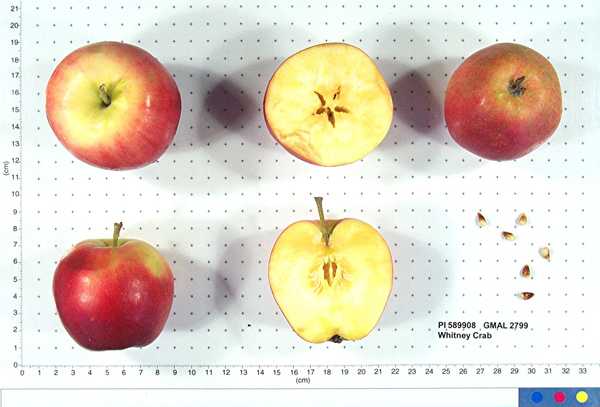Pomiferous
Welcome to the world's most extensive apples (pommes) database.
Information on over 7,000 apples is available here, all carefully researched and provided in a way that is easy to navigate.
Whitney

type: Cider, Eating, Jelly
synonyms: Whitney Crab, Whitney Number 20
identification: Small tending to medium size, round tending to conic. Yellow base colour over which is a pattern of bright red stripes. The stem is slender, set in a medium wide and deep cavity. The calyx can be medium to large, closed and sometimes partly open, set in a wide and shallow, pleated basin.
characteristics: The flesh is yellowish. Crisp, juicy, sweet-sharp, flavourful. Slightly astringent after-taste.
uses: Good for baking and fresh eating. Makes a flavourful apple jelly. Also used for cider.
origins: Grown by A.R. Whitney of Franklin Grove, Illinois (U.S.A.) during the mid-1800s as Whitney Number 20, one of three seedlings grown from among a large number of seeds taken from Siberian crabapples. First documented by Dr. John A. Warder in the 1869, Volume V edition of "Tilton's Journal of Horticulture."
cultivation: Moderately vigorous. Upright, spreading. Starts to produce first fruit quite young on its own roots. Does best in loamy, well-drained soils.
vulnerabilities: Resistant to fire blight. Somewhat resistant to scab, rust and mildew. Susceptible to mildew.
harvest: Ready for harvest late in the third period or early in the fourth..
notes: reddish bronze leaves.
pollination peak: 1
ploidism: Diploid. Self fertile, but produces best crops in the proximity of a source of compatible pollen.
brix: 12
harvest period: 3
flowers: Pink and white
fruit: round yellow red stripe Ripens at the start of autumn
hardiness: 2
Donate a cider?
©2016-2021 Pomiferous.com. All rights reserved